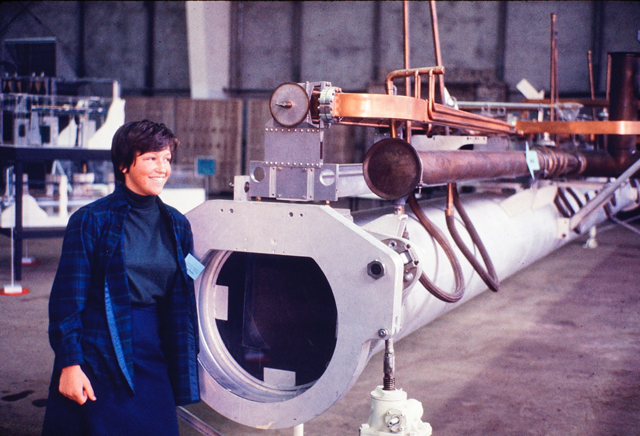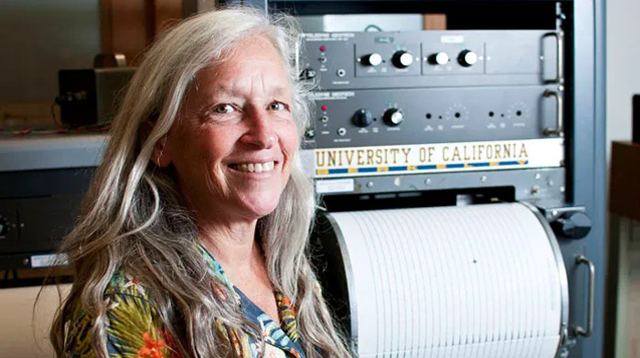16 May 2022–Peggy Hellweg was the first Explainer hired at the Exploratorium, a science, technology and arts museum in San Francisco, when it opened in 1969. The job as a young docent, engaging visitors and leading demonstrations, was a perfect fit for Hellweg.
She had grown up in a family of physicists, “where there was a lot of figuring out things and figuring out how you figure out things,” she recalled. “Helping people to understand was also what my father always did, how he interacted with us when there was something puzzling going on.”
In her former work as operations manager for the Berkeley Seismological Lab and now as SSA President, Hellweg still does her fair share of public speaking and explaining why seismological research matters to the public. “To me an important part of this is more listening than talking,” she said. “I want to know what you’re thinking about so that I can say something that fits into your framework, and broadens your framework.”
Hellweg found her career in seismology in Germany, where after earning a master’s in physics at the University of Göttingen, she went to work at the country’s Federal Institute for Geosciences and Natural Resources. The seismological laboratory there hosted the world’s first continuously recording broadband array. Lured by the incomparably rich data stream, prominent seismologists from around the world came to the institute while Hellweg was there. “Barbara Romanowicz, Adam Dziewoński, people were visiting all the time,” she recalls. “It was an example of how wonderful data could be.”

After returning to the U.S. and working with the U.S. Geological Survey on strong-motion earthquake arrays in California, in 2001 Hellweg started working as a post-doc at UC Berkeley, and became operations manager at the Berkeley Seismological Laboratory in 2005. She worked there until her retirement. At BSL, Hellweg oversaw a variety of seismic sensors and other geophysical instrumentation from borehole stations to strong motion sensors, deformation networks and broadband stations.
Her role included coordination of the BSL with the California Integrated Seismic Network (CISN) and the Advanced National Seismic System (ANSS), in addition to supervising, monitoring and coordinating the BSL’s field, computer and seismological operations.
Hellweg also served from 2011 to 2017 as a commissioner on the California Seismic Safety Commission, the state body responsible for providing California decision makers and the public with recommendations to reduce earthquake losses and speed recovery.
“One of the big things that’s happened in the last 40 years is the plethora of really excellent recording stations,” she said. “The simple instruments and recording systems from 40 years ago couldn’t capture as many details that we have now.”
As a result, “we’ve learned that earthquakes are really more complicated processes—each individual earthquake contains more complex processes than we thought,” she added.
One of the questions that came up most often in her public talks and interviews with reporters while at BSL was the possibility of predicting earthquakes, she said. “And I would have to say, we don’t collect enough data yet to be good at it. We didn’t get good at predicting the weather until we had satellites to observe what is going on everywhere.”

Hellweg has a long history of service with SSA. She previously served as SSA Secretary and co-chaired the 100thAnniversary Earthquake Conference, SSA’s joint meeting with the Earthquake Engineering Research Institute and Disaster Resistant California to commemorate the 1906 earthquake.
As SSA president, she would like to increase the Society’s international outreach and member diversity. Her time in Germany taught her that SSA’s U.S. members “have a very U.S.-centric view of research. But a lot of good work is being done outside of the U.S. and being published in non-U.S. journals,” Hellweg noted. “Improving our interactions with international institutions and members would be a good thing.”
She encourages seismologists to join SSA to take advantage of the valuable networking available through its programs and meetings. “At SSA you still have opportunities to look for new insights and exciting things and the people who appreciate them, and to discuss them and bring them into our fold of research topics.”
“The SSA is really in a good place right now, in terms of the new directions that it has been starting to go in the past few years,” she said. “It’s societally important in terms of our response to earthquakes and keeping people safe. These are all things that add value to SSA.”
SSA At Work is a monthly column that follows the careers of SSA members. For the full list of issues, head to our At Work page.
